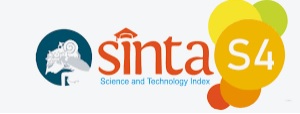Prediksi Timing Financial Distress Pada Bank Perkreditan Rakyat di Indonesia Menggunakan Machine Learning
Abstract
There is no system that can provide early warning of financial problems that threaten the operations of Rural Banks (BPR), so it is necessary to predict the timing of financial distress in BPRs in Indonesia using a two-stage classification and regression technique. Researchers used BPR financial report data in Indonesia for 4 years as a research sample, with a total of 150 Financial Ratio Data, consisting of 50 bankrupt financial ratio data and 100 non-bankrupt BPRs. Data analysis was carried out 2 years before being declared bankrupt. The target classification is divided into 5 classes: very healthy, healthy, moderately healthy, less healthy, distressed. The results of the study concluded: a two-stage classification and regression technique can be used to predict the timing of financial distress. This is evidenced by the results of the MLP Classifier classification with an accuracy rate of f1-score of 87%. The results of the evaluation of timing predictions using Random Forest Regression showed a mean absolute error of 1.8 months and a mean absolute percentage error of 4%.
Keywords: Rural Banks; Financial Distress; Random Forest Regression; Support Vector Machine
Abstrak
Belum ada suatu sistem yang dapat memberikan peringatan dini adanya permasalahan keuangan yang mengancam operasional Bank Perkreditan Rakyat (BPR), sehingga perlu memprediksi timing financial distress pada BPR di Indonesia menggunakan teknik dua tahap klasifikasi dan regresi. Peneliti menggunakan data laporan keuangan BPR di Indonesia selama 4 tahun sebagai sampel penelitian, dengan jumlah data 150 Data Rasio Keuangan, terdiri dari 50 Data rasio keuangan Pailit dan 100 BPR tidak pailit. Analisis Data dilakukan 2 tahun sebelum dinyatakan Pailit. Target klasifikasi dibagi menjadi 5 kelas: sangat sehat, sehat, cukup sehat, kurang sehat, distress. Hasil penelitian menyimpulkan: teknik dua tahap klasifikasi dan regresi dapat digunakan untuk memprediksi timing financial distress. Ini dibuktikan dengan hasil klasifikasi MLP Classifier dengan tingkat akurasi f1-score sebesar 87%. Hasil evaluasi prediksi timing menggunakan Random Forest Regression menunjukkan hasil mean absolute error sebesar 1,8 bulan dan hasil mean absolute percentage error sebesar 4%.
Â
Keywords
References
F. Rustandi, "Pengaruh Rgec (Risk Profile, Corporate Governance, Earnings, Capital) Terhadap Financial Distress Bank Perkreditan Rakyat Di Yogyakarta Periode 2015-2017," Universitas Islam Indonesia, 2020.
M. R. Hutauruk, M. Mansyur, M. Rinaldi, and Y. R. Situru, "Financial Distress Pada Perusahaan Yang Terdaftar Di Bursa Efek Indonesia," JPS (Jurnal Perbankan Syariah), vol. 2, no. 2, pp. 237-246, 2021.
R. Muflihah, "Analisis Financial Distress Bank Perkreditan Rakyat Syariah (BPRS) di Indonesia Periode 2019-2020," La Zhulma| Jurnal Ekonomi dan Bisnis Islam, vol. 1, no. 1, pp. 17-26, 2022.
I. P. Sari, A. Susbiyani, and A. A. Syahfrudin, "Analisis Faktor-Faktor Yang Mempengaruhi Kondisi Financial Distress Pada Perusahaan Yang Terdapat Di Bei Tahun 2016-2018 (Studi Empiris pada Perusahaan Manufaktur Sub Sektor yang Terdaftar di Bursa Efek Indonesia)," Jurnal Ilmiah Akuntansi dan Humanika, vol. 9, no. 2, pp. 1-12, 2019.
F. M. Sutra and R. G. Mais, "Faktor-Faktor yang Mempengaruhi Financial Distress dengan Pendekatan Altman Z-Score pada Perusahaan Pertambangan yang Terdaftar di Bursa Efek Indonesia Tahun 2015-2017," Jurnal Akuntansi Dan Manajemen, vol. 16, no. 1, pp. 34-72, 2019.
D. Diana, "Analisis Prediksi Kebangkrutan Menggunakan Model Altman Z-Score Pada Perusahaan Manufaktur Yang Terdaftar Di Bursa Effek Indonesia," Prodi Akuntansi, 2021.
I. Asfali, "Pengaruh Profitabilitas, Likuiditas, Leverage, Aktivitas, Pertumbuhann Penjualan Terhadap Financial Distress Perusahaan Kimia," Jurnal Ekonomi Dan Manajemen, vol. 20, no. 2, pp. 56-66, 2019.
A. Evayanti, "Faktor-Faktor Yang Mempengaruhi Financial Distress Dengan Menggunakan Metode Altman Z-Score Pada Perusahaan Manufaktur," UIN KH. Achmad Siddiq Jember, 2022.
H. Budiwati, "Analisis Rasio Keuangan Camel Terhadap Prediksi Kepailitan Pada Bank Umum Swasta Nasional Di Indonesia Periode 2004–2007," WIGA: Jurnal Penelitian Ilmu Ekonomi, vol. 1, no. 2, pp. 50-63, 2011.
H. Budiwati, I. Fadah, H. Sukarno, and E. S. Utami, "Bankruptcy Prediction Model Conventional Bank Rural Banks in Indonesia," PalArch's Journal of Archaeology of Egypt/Egyptology, vol. 18, no. 4, pp. 3790-3802, 2021.
E. L. Putri, "Prediksi financial distress dengan analisis risk, good corporate governance, earningsc Capital, dan size pada Bank Umum Swasta Nasional Devisa," MBR (Management and Business Review), vol. 2, no. 2, pp. 93-105, 2018.
Z. Achmat, "Theory of planned behavior, masihkah relevan," Jurnal Universitas Sumatera Utara, vol. 23, no. 2, pp. 1-20, 2010.
W. H. Beaver, "Financial ratios as predictors of failure," Journal of accounting research, vol. 4, pp. 71-111, 1966.
E. I. Altman, R. G. Haldeman, and P. Narayanan, "ZETATM analysis A new model to identify bankruptcy risk of corporations," Journal of banking & finance, vol. 1, no. 1, pp. 29-54, 1977.
P. A. Meyer and H. W. Pifer, "Prediction of bank failures," The journal of finance, vol. 25, no. 4, pp. 853-868, 1970.
J. F. Sinkey Jr, "A multivariate statistical analysis of the characteristics of problem banks," The Journal of Finance, vol. 30, no. 1, pp. 21-36, 1975.
F. Barboza, H. Kimura, and E. Altman, "Machine learning models and bankruptcy prediction," Expert Systems with Applications, vol. 83, pp. 405-417, 2017.
M. Kovacova and J. Kliestikova, "Modelling bankruptcy prediction models in Slovak companies," in SHS Web of Conferences, 2017, p. 01013.
S. S. Devi and Y. Radhika, "A survey on machine learning and statistical techniques in bankruptcy prediction," International Journal of Machine Learning and Computing, vol. 8, no. 2, pp. 133-139, 2018.
H. Chang, "The application of machine learning models in company bankruptcy prediction," in Proceedings of the 2019 3rd International Conference on Software and e-Business, 2019, pp. 199-203.
M. H. N. Yahya and M. H. Nasution, "Penggunaan Algoritma Support Vector Machine (SVM) Untuk Penentuan Kelayakan Pemberian Kredit Koperasi Serba Usaha ‘Daruzzakah Zakah’Desa Rensing Kecamatan Sakra Lombok Timur Nusa Tenggara Barat," Infotek J. Inform. dan Teknol, vol. 3, no. 1, pp. 32-41, 2020.
H. budiwati Soekirno, "Earnings dan Liquidity sebagai Prediktor Kepailitan Bank Perkreditan Rakyat di Indonesia," Jurnal Manajemen dan Keuangan, vol. 9, no. 2, pp. 248-264, 2020.
G. Al Qarana, & S. Sfenrianto, “Analisis Faktor Sosial-Ekonomi Pada Data Rekam Medik Pasien TB Menggunakan Teknologi MLP Classifier-ANN Dalam Kasus Kegagalan Pengobatan. Journals of Ners Community, vol. 13, no. 4, pp. 422-428, 2022.











